
Exposé Online
What's old
Exposé print issues (1993-2011)
- 1 (October 1993)
- 2 (February 1994)
- 3 (May 1994)
- 4 (August 1994)
- 5 (October 1994)
- 6 (March 1995)
- 7 (July 1995)
- 8 (November 1995)
- 9 (March 1996)
- 10 (August 1996)
- 11 (February 1997)
- 12 (May 1997)
- 13 (October 1997)
- 14 (February 1998)
- 15 (July 1998)
- 16 (January 1999)
- 17 (April 1999)
- 18 (November 1999)
- 19 (May 2000)
- 20 (October 2000)
- 21 (March 2001)
- 22 (July 2001)
- 23 (December 2001)
- 24 (April 2002)
- 25 (September 2002)
- 26 (February 2003)
- 27 (August 2003)
- 28 (December 2003)
- 29 (April 2004)
- 30 (September 2004)
- 31 (March 2005)
- 32 (September 2005)
- 33 (May 2006)
- 34 (March 2007)
- 35 (January 2008)
- 36 (October 2008)
- 37 (July 2009)
- 38 (July 2010)
- 39 (Summer 2011)
Features
From a Caricature to an Ambush —
Ange in the 70s
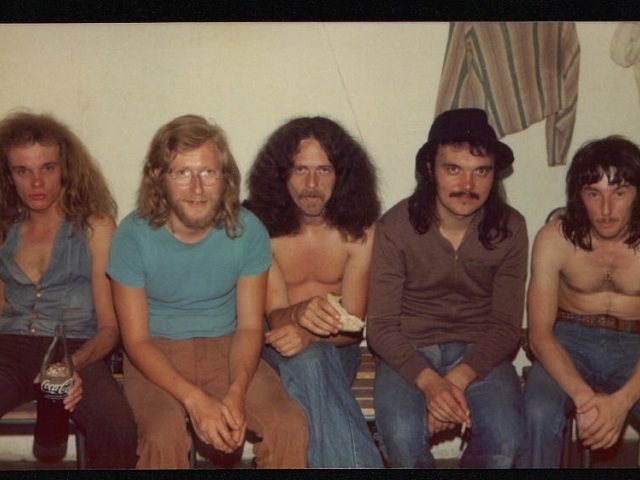
In the light of Musea's new tribute A Propos d'Ange and a new solo album by Christian Décamps, Exposé felt it would be an ideal time to take a look back at what was the beginning and arguably the peak of the career of one of France's most innovative and influential rock groups.
by Mike McLatchey, Published 1994-10-01
Ange released a total of six French language studio albums, two double live albums, and a compilation in the 1970s. While for many bands this may have stretched the good music way too far, Ange lasted through the decade with a string of essential albums, several of them of classic status.
Ange were undeniably a product of their culture, and were certainly influenced in many ways by the political situation in France in the late sixties. They made a distinctly French music – poignant, caustic and often satirical – that was a huge influence to many bands including Atoll, Mona Lisa, Memoriance, Grime, Orion, and others. Their poetic song style remains the forerunner for this type of music, certainly one that can seem quite alien to the mainstream influenced English-only ear. Admittedly, those who have a hard time adjusting to foreign dialects in music will have trouble absorbing Christian Décamps' distinct voicings. This may be partially the reason why the CD reissues have been largely overlooked by the progressive "underground" especially outside of France.
Ange's initial line-up consisted of Christian Décamps on vocals and additional keyboards; Francis Décamps on keys – including the organ sound that along with the vocals practically defined the Ange "sound"; Jean-Michel Brezovar on flute and mainly a tremendously underrated guitarist; and rhythm section Daniel Haas and Gerard Jelsch on bass and drums respectively. The band recorded an early single – 1970's "Israel/Cauchemar" (Caepe Disques JCP 25002) – before being signed to Philips, the label they would stay with until the mid 80s. Two singles followed in 1971: "Tout Feu, Tout Flamme/Dr. Mann" (Philips 6009 171) and "Le Soleil Est Trop Vert/Le Vieux de la Montagne" (Philips 6837 077), the A side of the first and B side of the latter making it to a later compilation in 1977. The band also recorded a live version of "Le Vieux de la Montagne" as their contribution to the Groovy Pop Session (Philips 6332 044) compilation, more famous for having the earliest recorded Pulsar track on it.
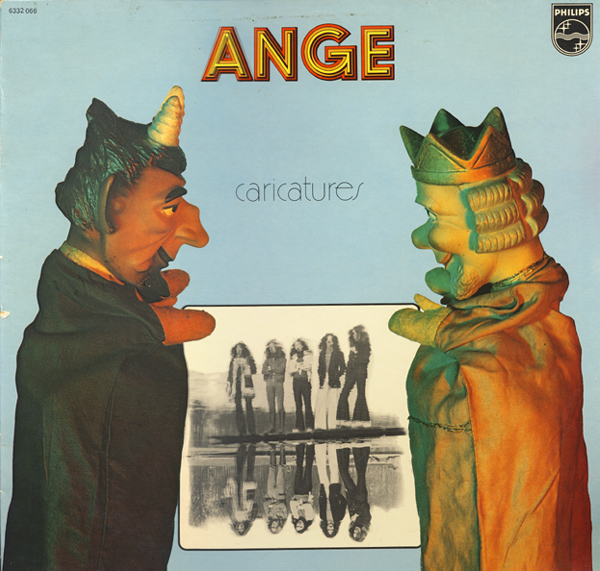 Ange's true debut was released in 1972 as Caricatures (Philips 6332 066) two years after they formed. This was a very strong debut and many of Ange's trademark musical elements can be detected here at an early stage. Heavily reverbed organ (which at times is nearly indistinguishable from a similarly effected Mellotron) is Ange's most noticeable musical characteristic. The sound gives the music an almost archaic and ancient feel that is totally indigenous to the group. Also noticeable is Brezovar's expressive and often under-mixed guitar playing which adds an emotive and intense feel to the music. The production here is fairly dated for 1972, which adds to the semi-gothic sound of the album. While arguably behind the "progressive" efforts of their English contemporaries like Genesis or Yes, it still must be noted that Ange's tendency for a poetic song styling and unusual rhythms is quite unique for a debut; completely eschewing the commerciality inherent in the aforementioned groups. Ange's diversity, a similarity between many of their albums, is already evident early on, from the anthem-like and classic "Dignité" to the ballad "Le Soir du Diable" to the instrumental opener and closer "Biafra 80 (Introduction/Final)" (although the Final's bizarre avant-rock collage was an element onlyn found in their early music). Overall, Caricatures is a very strong and underrated debut, perhaps due to the higher caliber of their later and more mature output. A single, "Caricatures/Dignité" (Philips 6837 077) was also released.
Ange's true debut was released in 1972 as Caricatures (Philips 6332 066) two years after they formed. This was a very strong debut and many of Ange's trademark musical elements can be detected here at an early stage. Heavily reverbed organ (which at times is nearly indistinguishable from a similarly effected Mellotron) is Ange's most noticeable musical characteristic. The sound gives the music an almost archaic and ancient feel that is totally indigenous to the group. Also noticeable is Brezovar's expressive and often under-mixed guitar playing which adds an emotive and intense feel to the music. The production here is fairly dated for 1972, which adds to the semi-gothic sound of the album. While arguably behind the "progressive" efforts of their English contemporaries like Genesis or Yes, it still must be noted that Ange's tendency for a poetic song styling and unusual rhythms is quite unique for a debut; completely eschewing the commerciality inherent in the aforementioned groups. Ange's diversity, a similarity between many of their albums, is already evident early on, from the anthem-like and classic "Dignité" to the ballad "Le Soir du Diable" to the instrumental opener and closer "Biafra 80 (Introduction/Final)" (although the Final's bizarre avant-rock collage was an element onlyn found in their early music). Overall, Caricatures is a very strong and underrated debut, perhaps due to the higher caliber of their later and more mature output. A single, "Caricatures/Dignité" (Philips 6837 077) was also released.
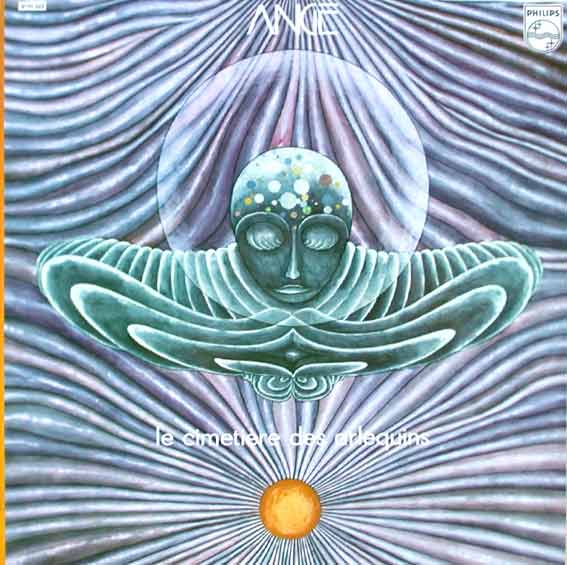 1973's Le Cimetière des Arlequins (Philips 6325 037) showed very little stylistic change as a whole. There was a further development of their song style taking hold, yet the overall effect was very close to that of Caricatures. High points of their sophomore effort include another spine tingling Brezovar guitar solo in the Jacques Brel composition "Ces Gens-La," the "Bivouac" suite with some rare organ soloing, and the first of what would become a tradition for the band, a long track to close the album (in this case it's the title track), a tradition they would observe for the next four studio albums. While not really too much of a change, Cimetière still remains a great and recommended album.
1973's Le Cimetière des Arlequins (Philips 6325 037) showed very little stylistic change as a whole. There was a further development of their song style taking hold, yet the overall effect was very close to that of Caricatures. High points of their sophomore effort include another spine tingling Brezovar guitar solo in the Jacques Brel composition "Ces Gens-La," the "Bivouac" suite with some rare organ soloing, and the first of what would become a tradition for the band, a long track to close the album (in this case it's the title track), a tradition they would observe for the next four studio albums. While not really too much of a change, Cimetière still remains a great and recommended album.
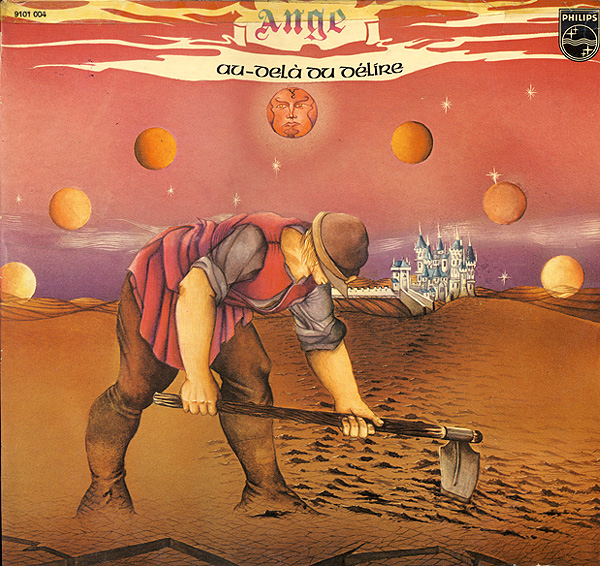 Ange's peak arguably started with their third, magnificent, and possibly best album Au-Delà du Délire (Philips 9101 004, 1974). Immediately noticeable is the much clearer and updated production that eluded their previous output. While the typically warbly organ still remained at the root of their sound, the more vibrant overall richness resulted in the big step up the band needed. Guests Eric Bibonne, Michel Lefloch (vocals), and Henry Loustau (violin) also contributed to the widened palate. Every song here is a gem – the powerful and tortured "Les Longues Nuits d'Isaac," the beautiful "Ballade pour une Orgie" the majestic and incredible "Exode" with a superb and overwhelming guitar solo and finale, and the aptly delirious self-titled suite that closes the album. Every track flows perfectly as a whole, like a haunting and mesmerizing story line. This album remains as the zenith of French symphonic rock; an essential masterpiece and possibly one of the best albums in this vein every recorded.
Ange's peak arguably started with their third, magnificent, and possibly best album Au-Delà du Délire (Philips 9101 004, 1974). Immediately noticeable is the much clearer and updated production that eluded their previous output. While the typically warbly organ still remained at the root of their sound, the more vibrant overall richness resulted in the big step up the band needed. Guests Eric Bibonne, Michel Lefloch (vocals), and Henry Loustau (violin) also contributed to the widened palate. Every song here is a gem – the powerful and tortured "Les Longues Nuits d'Isaac," the beautiful "Ballade pour une Orgie" the majestic and incredible "Exode" with a superb and overwhelming guitar solo and finale, and the aptly delirious self-titled suite that closes the album. Every track flows perfectly as a whole, like a haunting and mesmerizing story line. This album remains as the zenith of French symphonic rock; an essential masterpiece and possibly one of the best albums in this vein every recorded.
 Around this time, drummer Gerard Jelsch left and was replaced by Guenole Biger. Flowing with musical ideas and originality, the band barely missed a step with their fourth album, a concept built around the tales of Emile Jacotey (Philips 9101 012, 1975). This album is noticeably more upbeat and rocking, especially on the opening track. Linked by narration (Emile), the music flows arguably even more effectively than on the previous album. Again, this is a splendid display of color, dynamics, multi-timbral subtlety and harmonic complexity that belies its aesthetically straightforward song style. As a pointer, this is probably the best place to start as a newcomer to Ange's studio albums as it falls in the middle between their early style and a more atmospheric and reflective style to come. Philips released two singles from the album – "Jour après Jour/Bêle Bêle Petite Chèvre" (Philips 6837 311) and "Ode à Emile/Sur la Trace des Fées" (Philips 6837 2171) – all incredible music from a brilliant album.
Around this time, drummer Gerard Jelsch left and was replaced by Guenole Biger. Flowing with musical ideas and originality, the band barely missed a step with their fourth album, a concept built around the tales of Emile Jacotey (Philips 9101 012, 1975). This album is noticeably more upbeat and rocking, especially on the opening track. Linked by narration (Emile), the music flows arguably even more effectively than on the previous album. Again, this is a splendid display of color, dynamics, multi-timbral subtlety and harmonic complexity that belies its aesthetically straightforward song style. As a pointer, this is probably the best place to start as a newcomer to Ange's studio albums as it falls in the middle between their early style and a more atmospheric and reflective style to come. Philips released two singles from the album – "Jour après Jour/Bêle Bêle Petite Chèvre" (Philips 6837 311) and "Ode à Emile/Sur la Trace des Fées" (Philips 6837 2171) – all incredible music from a brilliant album.
 1976's Par les Fils du Mandrin brought a subtle yet noticeable change in style, and was their best selling album to date. Jean-Pierre Guichard replaced Biger as full time drummer, subtly bringing a change in tone and mood. This album is much more restrained, reflective, and melancholy than previous efforts. There is some narration, much of it during the quieter sections, and the overall effect is far less immediate and powerful than the previous four albums. Much of the music is very quiet and atmospheric, and while the Ange sound remained intact, the album is much less striking than would be expected after Emile Jacotey. Relatively speaking of course – there are some jewels here – the laid back title track, the rich "Des Yeux Couleur d'Enfents" (one of their many classics), and the three part closer, "Hymne à la Vie." Overall, another good album, yet not quite as initially impressive. There is also a very rare English vocal version that never saw wide distribution called By the Sons of Mandrin.
1976's Par les Fils du Mandrin brought a subtle yet noticeable change in style, and was their best selling album to date. Jean-Pierre Guichard replaced Biger as full time drummer, subtly bringing a change in tone and mood. This album is much more restrained, reflective, and melancholy than previous efforts. There is some narration, much of it during the quieter sections, and the overall effect is far less immediate and powerful than the previous four albums. Much of the music is very quiet and atmospheric, and while the Ange sound remained intact, the album is much less striking than would be expected after Emile Jacotey. Relatively speaking of course – there are some jewels here – the laid back title track, the rich "Des Yeux Couleur d'Enfents" (one of their many classics), and the three part closer, "Hymne à la Vie." Overall, another good album, yet not quite as initially impressive. There is also a very rare English vocal version that never saw wide distribution called By the Sons of Mandrin.
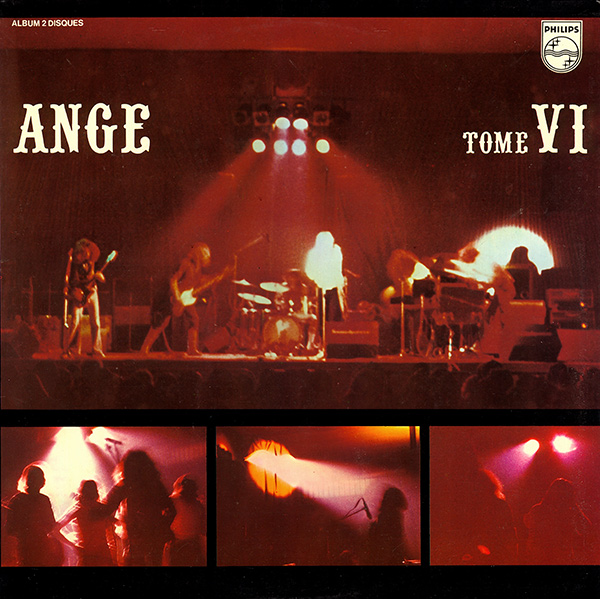 Ange's Tome VI was released in 1977 as the first of two double live albums that year. As a live album, Tome VI (Philips 6641 715) portrays the Ange experience in a different setting. Ange were a remarkable band live, with variations in material that show a band still continuing to improve their music as an evolving art form. For example – the side long version of "Dignité" is a much more dramatic and elaborated version than on Caricatures. Due to time restraints, not every classic is present, but excellent are the ones here – with the intense opener, a quicker paced "Fils de Lumière" and a very emotional and convincing "Sur la Trace des Fées" – to name a few. The Baillemont CD reissue adds the excellent out-take, the 13 minute "Le Chien, la Poubelle, et la Rose" which adds up to make this CD well worth the money and an ideal introduction.
Ange's Tome VI was released in 1977 as the first of two double live albums that year. As a live album, Tome VI (Philips 6641 715) portrays the Ange experience in a different setting. Ange were a remarkable band live, with variations in material that show a band still continuing to improve their music as an evolving art form. For example – the side long version of "Dignité" is a much more dramatic and elaborated version than on Caricatures. Due to time restraints, not every classic is present, but excellent are the ones here – with the intense opener, a quicker paced "Fils de Lumière" and a very emotional and convincing "Sur la Trace des Fées" – to name a few. The Baillemont CD reissue adds the excellent out-take, the 13 minute "Le Chien, la Poubelle, et la Rose" which adds up to make this CD well worth the money and an ideal introduction.
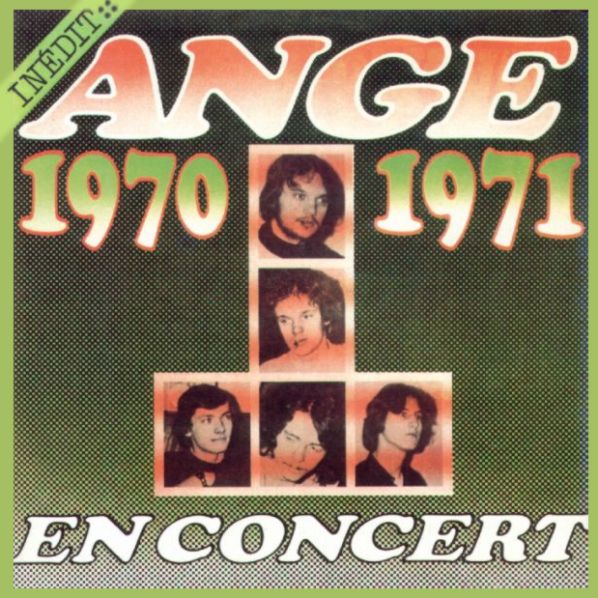 Also released by RCA in 1977 was the double live early retrospective album 1970/1971 en Concert, a compilation of Ange's very early years live. Much of the music here is far different from Tome VI and in many ways even far off from their debut album itself. This Ange is the Ange of the early singles: much in the way bands like the New Trolls or Le Orme began, as a beat group. The Beatles, Yardbirds, early Grateful Dead and Santana all are subtle factors to their music, an experimental and expressive rock played with vigor and energy. Brezovar's guitar is much farther up front here than it would be later on, giving the music a slightly harder edge. While you can hear psychedelic embryonic parts of Caricatures most of this will not sound anything like the Ange of 1972 plus, probably more of an appeal to psych fans than other genres.
Also released by RCA in 1977 was the double live early retrospective album 1970/1971 en Concert, a compilation of Ange's very early years live. Much of the music here is far different from Tome VI and in many ways even far off from their debut album itself. This Ange is the Ange of the early singles: much in the way bands like the New Trolls or Le Orme began, as a beat group. The Beatles, Yardbirds, early Grateful Dead and Santana all are subtle factors to their music, an experimental and expressive rock played with vigor and energy. Brezovar's guitar is much farther up front here than it would be later on, giving the music a slightly harder edge. While you can hear psychedelic embryonic parts of Caricatures most of this will not sound anything like the Ange of 1972 plus, probably more of an appeal to psych fans than other genres.
1977 also heralded the release of a "greatest hits collection" Ange Chante Ses Plus Grands Succes a retrospective from 1971-1976 including the two singles tracks mentioned earlier.
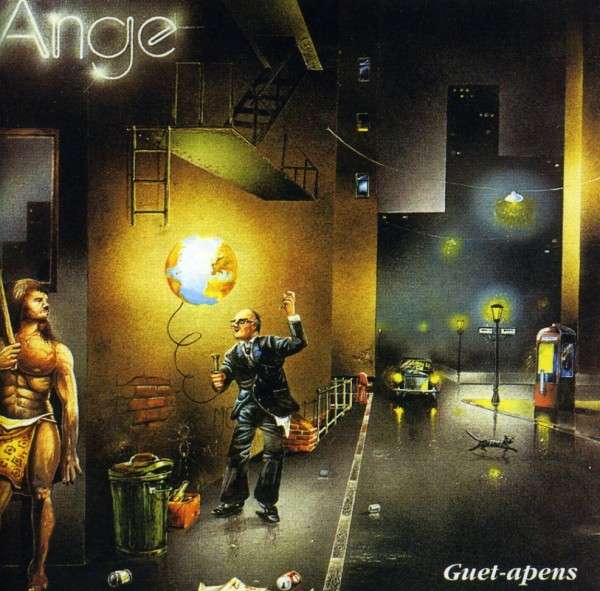 Ange returned to the studio in 1978 as a changed line up again with the Décamps, Guichard and new members Claude Demet on guitar and Gerald Renard on bass. As a result, Guet-Apens (Philips 9101184) had a different feel, this time much more spacey with a soaring edge. Francis Décamps uses the Mellotron more than in the past and the overall effect is like Pink Floyd, or much more closely, the Pulsar of Strands of the Future.
Ange returned to the studio in 1978 as a changed line up again with the Décamps, Guichard and new members Claude Demet on guitar and Gerald Renard on bass. As a result, Guet-Apens (Philips 9101184) had a different feel, this time much more spacey with a soaring edge. Francis Décamps uses the Mellotron more than in the past and the overall effect is like Pink Floyd, or much more closely, the Pulsar of Strands of the Future.
Excellent music with two long tracks to begin and end the album, the closer "Le Captain Coeur de Miel" is worth the album by itself. Another excellent and surprisingly overlooked album.
Ange's two original members both departed to make solo albums in 1979, and later reformed Ange in 80s as a band with a far different and much more straightforward sound that in many ways leaves the focus of this magazine. The Ange sound of the 70s ended with Guet-Apens.
Many of the CDs here are not as widely distributed as even many of the independents. The majority were released as limited editions by Philips, although with a little trouble they shouldn’t be too hard to track down, and will possibly face reissue again in the future. Ange were a singular event in European rock, and are not to be missed.
Filed under: Profiles, Issue 5
Related artist(s): Ange, Christian Décamps
What's new
These are the most recent changes made to artists, releases, and articles.
- Review: L'Impero delle Ombre - Oscurità
Published 2025-12-08 - Review: Derek Shulman - Giant Steps
Published 2025-12-07 - Review: Kronstad 23 - Sommermørket
Published 2025-12-06 - Review: Ashley Reaks - At Night the World Belongs to Me
Published 2025-12-05 - Review: Kevin Kastning / Sándor Szabó - To Capture the Light & Kevin Kastning / Carl Clements - Though Seldom Revealed
Published 2025-12-04 - Review: Revolutionary Snake Ensemble - Serpentine
Published 2025-12-03 - Release: Derek Shulman with Jon Wiederhorn - Giant Steps
Updated 2025-12-02 14:23:13 - Release: Inclusion Principle - Needle at the Bottom of the Sea
Updated 2025-12-02 14:20:07 - Release: John Greaves - Chanson d'Automne
Updated 2025-12-02 14:18:07 - Release: Anton Roolaart - The Ballad of General Jupiter
Updated 2025-12-02 14:15:56 - Artist: Anton Roolaart
Updated 2025-12-02 14:15:19 - Release: Son Reis Project - Payment Plan
Updated 2025-12-02 14:11:45 - Release: Son Reis Project - Son Reis Project
Updated 2025-12-02 14:11:16 - Artist: Son Reis Project
Updated 2025-12-02 14:09:27 - Review: Claudio Scolari Project - Bloom
Published 2025-12-02 - Release: Claudio Scolari Project - Bloom
Updated 2025-12-01 23:50:49 - Review: Barend Tromp - Juvenile Fish Tales & Odd Time Concepts
Published 2025-12-01 - Review: Zhongyu - Super Z Attack Team
Published 2025-11-30
